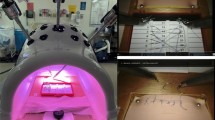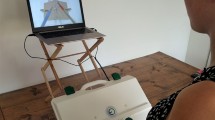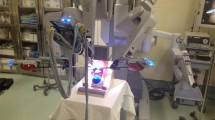Abstract
The purpose of this study is to evaluate the effectiveness of virtual reality (VR) simulation versus dry lab suturing practice at improving suturing performance in robotic surgery. Nineteen novice participants with no prior robotic suturing experience were randomized to two groups, VR simulation and dry lab, which consisted of inanimate training on a da Vinci Si surgical system. Each group underwent baseline suturing evaluation, then trained on the Simbionix™ Suturing Module (SSM) or undertook suturing practice using the da Vinci Surgical System in a dry lab. Final suturing performance was evaluated using the objective suture scoring method. Participants in the VR simulation group were surveyed to assess the face and content validity of the SSM. Both groups experienced significant improvement after training (VR simulation group p = 0.0078; dry lab group p = 0.0039). There was no significant difference in improvement between the two groups after undergoing training with either SSM or in the dry lab. Improvements in composite timing scores were 123 and 172 in the VR simulation and dry lab test groups, respectively (p = 0.36). Face validation varied with respect to the category assessed, but participants confirmed content validity of the SSM in all categories. In this sample of novice operators, there was no significant advantage in training with VR simulation using the SSM over dry lab training in improving suturing performance. Users of the SSM found it useful and relevant as a training tool for improving suturing performance.


Similar content being viewed by others
References
Raman JD, Dong S, Levinson A et al (2007) Robotic radical prostatectomy: operative technique, outcomes, and learning curve. JSLS 11:1
Ou YC, Yang CR, Wang J et al (2011) The learning curve for reducing complications of robotic-assisted laparoscopic radical prostatectomy by a single surgeon. BJU Int 108(3):420–425
Steinberg PL, Merguerian PA, Bihrle W III et al (2008) The cost of learning robotic-assisted prostatectomy. Urology 72:1068–1072
Society of American Gastrointestinal and Endoscopic Surgeons. FLS Program Description. http://www.flsprogram.org/index/fls-program-description/. Accessed 27 Sep 2013
Arikatla VS, Ahn W, Sankaranarayanan G, De S (2013) Towards virtual FLS: development of a peg transfer simulator. Int J Med Robot. doi:10.1002/rcs.1534
Stegemann AP, Ahmed K, Syed JR et al (2013) Fundamental skills of robotic surgery: a multi-institutional randomized controlled trial for validation of a simulation-based curriculum. Urology 81(4):767–774
Kelly DC, Margules AC, Kundavaram CR et al (2012) Face, content, and construct validation of the da Vinci Skills Simulator. Urology 79(5):1068–1072
Simbionix™ Press Releases. http://simbionix.com/2012/12/05/innovative-simulation-solutions-change-surgical-education-simbionix-launches-four-new-products-at-acs/. Accessed 27 Sep 2013
Lerner MA, Ayalew M, Peine WJ, Sundaram CP (2010) Does training on a virtual reality robotic simulator improve performance on the da Vinci surgical system? J Endourol 24(3):467–472
Derossis AM, Fried GM, Abrahamowicz M et al (1998) Development of a model for training and evaluation of laparoscopic skills. Am J Surg 175(6):482–487
Ritter EM, Scott DJ (2007) Design of a proficiency-based skills training curriculum for the fundamentals of laparoscopic surgery. Surg Innov 14(2):107–112
Dauster B, Steinberg AP, Vassiliou MC et al (2005) Validity of the MISTELS simulator for laparoscopy training in urology. J Endourol 19(5):541–545
Tergas AI, Sheth SB, Green IC et al (2013) A pilot study of surgical training using a virtual robotic surgery simulator. JSLS 17(2):219–226
Acknowledgments
All statistical analysis performed by Jocelyn Andrel Sendecki, MSPH of Thomas Jefferson University Department of Pharmacology and Experimental Therapeutics, Division of Biostatistics.
Conflict of interest
Costas D. Lallas declares that he has no conflict of interest. Michael J. Amirian declares that he has no conflict of interest. Samuel M. Lindner declares that he has no conflict of interest. Edouard J. Trabulsi declares that he has no conflict of interest.
Author information
Authors and Affiliations
Corresponding author
Appendix—Validity Survey
Appendix—Validity Survey
Face Validity:
Draw a vertical line on the visual analog scale (VAS) for the following.
(1 = totally unlike surgery. 5 = identical to actual surgery)
Commentary:
Content Validity:
Draw a vertical line on the VAS to indicate simulator usefulness in training for the following. (1 = not relevant or useful. 5 = very relevant and useful)
Commentary:
Rights and permissions
About this article
Cite this article
Amirian, M.J., Lindner, S.M., Trabulsi, E.J. et al. Surgical suturing training with virtual reality simulation versus dry lab practice: an evaluation of performance improvement, content, and face validity. J Robotic Surg 8, 329–335 (2014). https://doi.org/10.1007/s11701-014-0475-y
Received:
Accepted:
Published:
Issue Date:
DOI: https://doi.org/10.1007/s11701-014-0475-y




